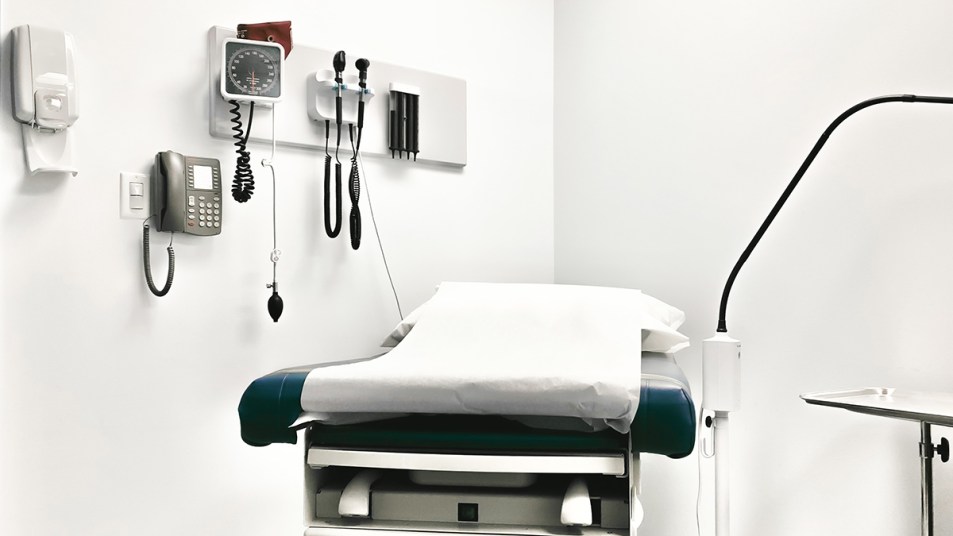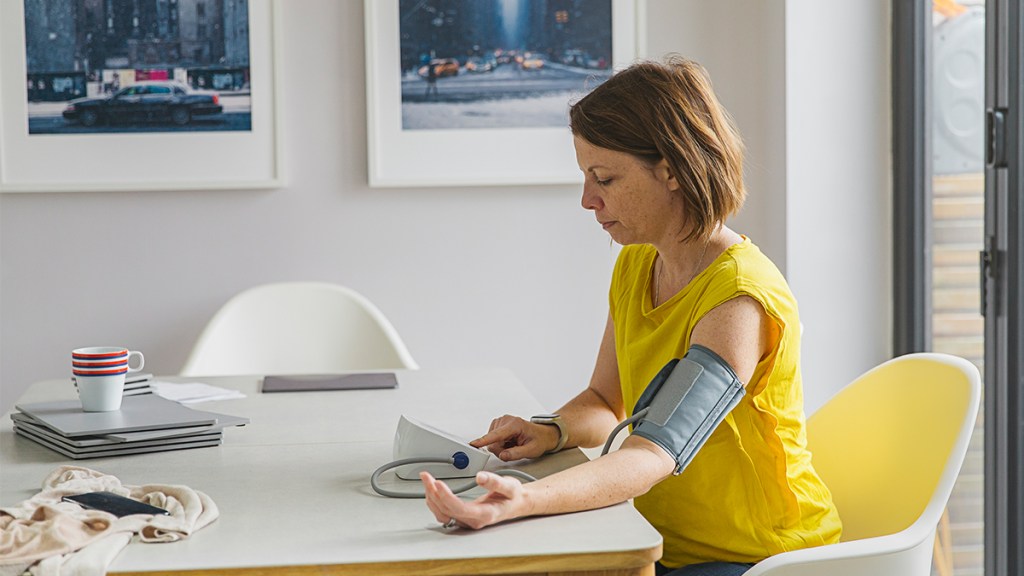‘White Coat Hypertension’: What Doctors Want You to Know If Your Blood Pressure Goes Up at the Doctor’s Office
If just looking at this photo makes your heart beat faster, you'll want to read this

It’s time for your annual physical, and simply thinking about it fills you with a sense of dread that descends like a curtain. This anxiety — whether it be worry over receiving test results or concern about being weighed or judged in some way — can lead to white coat hypertension, a phenomenon in which this nervousness you feel elevates blood pressure results. This can be a problem for two reasons: (1) It’s important to get an accurate blood pressure reading, and (2) having elevated blood pressure in response to nervousness can be associated with a higher incidence of cardiac problems. We spoke with a cardiologist and a psychiatrist to understand what really causes this white coat hypertension — and tips to beat white coat hypertension.
What is white coat hypertension?
“White coat hypertension happens when anxiety causes increased heart rate and elevated blood pressure in a clinical setting, like a doctor’s office, leading to a higher reading than it would have been if you took your blood pressure at home,” explains cardiologist Kyla Lara-Breitinger, MD, Co-Director of the Cardiometabolic Program, Division of Preventive Cardiology Department of Cardiovascular Medicine at the Mayo Clinic. This syndrome has been around “since the time doctors first started wearing white coats,” she says. In fact, according to research in the journal Hypertension, up to 60% of people have experienced it.
It’s important to note that white coat hypertension is not the same as a panic attack, explains psychiatrist Erika Balfour, MD, author Being an Empowered Patient. “A panic attack comes out of nowhere and is marked by shakiness, dizziness, chest pain. It feels like you’re having a heart attack, and your doctor will instantly recognize it,” she says. “Anxiety is more like a fear, a worry something is going to happen or that a test result isn’t going to be normal.” In other words, white coat syndrome is “sneakier” and tends to be harder for your doctor to spot. All the more reason to empower yourself by learning how it manifests and how stop it in its tracks.
Why it’s important to address white coat hypertension
“Research shows people who suffer from white coat hypertension are more likely to have heart issues in the future,” reveals Dr. Balfour. In fact, a study in Annals of Internal Medicine showed that untreated white coat hypertension is associated with a higher likelihood of having a cardiac event, such as a heart attack — especially in people over 55. That’s why it’s key to alert your doctor if you know you experience white coat hypertension — and take simple stress-relieving steps to outsmart it.
4 pre-visit tips to beat white coat hypertension
If knowledge is power, preparation is your superpower. Here, simple strategies that’ll help you feel calm and in control before your appointment.
1. Practice at home

The first step is to take control by knowing your baseline blood pressure. Many pharmacies offer free blood pressure checks, notes Dr. Lara-Breitinger, adding that you might also consider picking up an inexpensive blood pressure cuff (One option: Blood Pressure Monitor, AILE Blood Pressure Machine Upper Arm Cuff (Buy on Amazon, $24.99). “Take your blood pressure three times to ensure the reading is consistent, and make sure the cuff is the right size for you. If it’s too big or small, it can under-or overestimate your blood pressure.” She adds that taking readings at different times during the day will give you a more accurate reading, as will taking the device to your doctor to make sure it’s calibrated correctly.
In most cases, blood pressure should ideally be 120/80 mm/Hg, and that holds true even in your golden years, says Dr. Lara-Breitinger. “It was once thought that older people — 65 to 75 years old — shouldn’t let their blood pressure get too low, or they may become light-headed, faint and hurt themselves.” But experts have debunked this theory. “As long as they’re not light-headed, I tell older patients controlling blood pressure is much healthier. Because medicine keeps advancing, if we take care of our vascular health, there’s nothing stopping us from living to 100!”
2. Consider recruiting a buddy
This is one of the best tips to beat white coat hypertension. Indeed, asking a trusted friend or loved one to accompany to your appointment can allay anxiety and help ensure your blood pressure remains in the normal range, notes Dr. Balfour. And a recent study in Psychoneuroendocrinology shows that social support significantly bolsters resilience in stressful situations in large part by slashing cortisol, the anxiety-provoking hormone that causes blood pressure to spike.
3. Express yourself
If you’ve struggled with white coat hypertension in the past, call your doctor and let them know ahead of your appointment. “Tell them this something you’ve experienced,” suggests Dr. Balfour. “They might suggest doing other tests before they get to your blood pressure, so you have time to get used to the setting and relax.” She adds that you may also want to ask them to take your blood pressure in a quiet space, if possible.
4. Breathe away tension
Soothing stress over the long-term helps lower blood pressure and dial down jitters before heading to the doctor. One strategy Dr. Balfour recommends is box breathing, because it activates the calming parasympathetic nervous system. A study in Cell Reports shows that doing just five minutes a day of deep breathing for a month significantly deceases anxiety
“I recommend finding a video of the technique on YouTube (see below) and watching it right on your phone — you can even do it in the waiting room,” says Dr. Balfour. “Stimulating your visual sense like this intensifies the relaxing effects and makes it easier to follow along, as you can see the box being created as you breathe.”
To do:
- 1. Breathe in, counting to four slowly.
- 2. Hold your breath for four seconds.
- 3. Slowly exhale through your mouth for a count of four.
For an easy-to-follow video of box breathing, check out the video below:
What to do at the doctor’s office to beat white coat hypertension

Once you set foot in the clinic or office, it’s time to be your best advocate. Here, pro tips to beat white coat hypertension, plus simple ways to communicate with your medical professional — and with yourself.
1. Ask about this blood pressure tool
When Dr. Lara-Breitinger sees that a patient is experiencing white coat syndrome, she sometimes breaks out the big guns: “If they tell me, ‘I check it all the time, and it’s never been this high,’ I may ask them to wear a six-hour ambulatory blood pressure monitor.” The monitor takes your blood pressure throughout the day while you’re going about your normal routine. “It looks like a purse you wear over one shoulder,” she says. Because it’s continually checking your blood pressure, it gives you an average result that’s more accurate than a single reading. Dr. Lara-Breitinger admits this is an “aggressive option,” but if there is an especially big discrepancy between your at-home and in-office numbers, it may help rule out false readings or other health issues.
2. Powder your nose
Once you’re in the office, asking to use the restroom can help you gather your thoughts and feel calmer, observes Dr. Balfour. “Sometimes clearing your body lets you clear your mind and physiologically reset.” In fact, medical professionals are trained to wait five minutes before they take your blood pressure, in part to give you enough time to make sure you don’t need to pee, because that can alter your blood pressure results, adds Dr. Lara-Breitinger.
3. Show yourself compassion
“I know when my husband tells me to relax, it does just the opposite,” laughs Dr. Lara Breininger. The same is true when we tell ourselves to calm down. Instead of beating yourself up for your anxiety at the doctor’s office or admonishing yourself to relax, she encourages “showing yourself grace.” After all, for the vast majority of people, “white coat hypertension is not something that’s going to follow you around and have repercussions.”
And if your thoughts start racing out of fear that your blood pressure is going to be high, Dr. Balfour recommends reframing that negative distortion by reminding yourself of the facts: “I’ve been exercising and eating right, and I think my blood pressure will be fine this time. And if it isn’t, I can tackle that, too.”
More ways to curb doctor-induced anxiety
It isn’t just the specter of getting your blood pressure taken that dials up worry at the doctor’s office. Everything from being body-shamed to the fear of bad news can lead to anxiety, says Dr. Balfour. Read on for a few easy ways to defuse such triggers and cue calm fast.
Outsmart body bias
If you’re like 52% of women who say their weight has gotten in the way of the best medical care and your doctor keeps returning to that default rationale for your symptoms, you might ask him or to justify their position. Say, “How does my weight explain the pain in my arm? What else could it be?” suggests Teri Dreher, RN, author of How to be a Healthcare Advocate for Yourself and Your Loved Ones. “Or you might say, ‘I know something isn’t right, and I’d like you to keep looking.’ Says Dreher, “You can even acknowledge their initial diagnosis by saying, ‘I thought it was X at first, too, but I don’t think so anymore.’ Just keep advocating for yourself to ensure they hear you.
Seek out peer pressure
It’s natural to be wary of getting a scary diagnosis, but when that worry manifests in the classic defense mechanism of avoidance, it can prevent you from getting vital preventive care. The solution may be peer pressure – in a good way. “If you realize you’re experiencing this kind of anxiety and avoiding your annual check-ups out of fear, you might tell a friend, ‘Hey, remind me in October to schedule X appointment (like a mammogram or physical) because I’m going to need that nudge,” urges Dr. Balfour. Oftentimes, it just takes saying it out loud and creating a little accountability to motivate us to seek the medical care we all deserve.
This content is not a substitute for professional medical advice or diagnosis. Always consult your physician before pursuing any treatment plan.
For more anxiety cures, keep reading:
Revolutionary ‘Tapping’ Technique Dials Down Anxiety By 67% in 10 Minutes
30 Journal Prompts That Boost Bliss, Slash Stress and Ease Anxiety — In Minutes!
How and Why Weighted Blankets Help to Ease Anxiety and Depression












